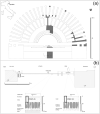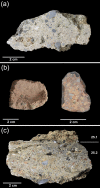Early exploitation of Neapolitan pozzolan (pulvis puteolana) in the Roman theatre of Aquileia, Northern Italy
- PMID: 36914680
- PMCID: PMC10011562
- DOI: 10.1038/s41598-023-30692-y
Early exploitation of Neapolitan pozzolan (pulvis puteolana) in the Roman theatre of Aquileia, Northern Italy
Abstract
The paper reports the results of the analyses on mortar-based materials from the Roman theatre of Aquileia (Friuli Venezia Giulia, Northern Italy), recently dated between the mid-1st Century BCE and the mid-1st Century CE. Samples were characterized by Polarized Light Microscopy on thin sections (PLM), Scanning Electron Microscopy with Energy Dispersive Spectroscopy (SEM-EDS) and Quantitative Phase Analysis by X-Ray Powder Diffraction (QPA-XRPD). Pyroclastic aggregates (mainly pumices and scattered tuffs), incompatible with the regional geology, were found in two samples from the preparation layers of the ground floor of the building. Their provenance was determined by means of QPA-XRPD, SEM-EDS, X-Ray Fluorescence (XRF) and Laser-Ablation Inductively-Coupled-Plasma Mass-Spectrometry (LA-ICP-MS). Mineralogical and geochemical analyses demonstrated their provenance from the Bay of Naples, thus recognizing them as pulvis puteolana, a type of pozzolanic aggregate outcropping around the modern town of Pozzuoli and prescribed by Vitruvius (De Architectura, 2.6.1) in mortar-based materials to strengthen masonries and produce hydraulic concrete for harbor piers. This evidence represents the oldest analytically-established case of pulvis puteolana exploitation in Northern Italy up to now, and an early use of the material out of Campania adapted for civil constructions in a non-strictly maritime-related environment. Indeed, the theatre was built in the low-lying Aquileia's deltaic plain, prone to water infiltrations that are typical in lagoon-like environments. The data highlight the craftsmen's resilience in adapting and reinterpreting the traditional use of the Neapolitan volcanic materials to deal with the geomorphological challenges of Aquileia's lowland.
© 2023. The Author(s).
Conflict of interest statement
The authors declare no competing interests.
Figures










References
-
- Mortureux, B., Hornain, H., Gautier, E. & Regourd, M. Comparison of the reactivity of different pozzolans. In Proc. of the 7th International Congress on the Chemistry of Cement IV, 110–115 (1980).
-
- Cook, D. J. Natural pozzolanas. In Cement Replacement Materials (ed. Swamy, R. N.) 1–39 (1986).
-
- Massazza, F. Pozzolana and Pozzolanic Cement. In Lea's Chemistry of Cement and Concrete (ed. Hewlett, P. C.) 471–635 (1998).
-
- Snellings R, Mertens G, Elsen J. Supplementary cementitious materials. Rev. Mineral. Geochem. 2012;74:211–278. doi: 10.2138/rmg.2012.74.6. - DOI
-
- Artioli G., Secco, M., Addis, A. & Bellotto, M. Role of hydrotalcite-type layered double hydroxides in delayed pozzolanic reactions and their bearing on mortar dating in Cementitious Materials: Composition, Properties, Application (ed. Pöllmann, H.) 147–158 (2017).
Grants and funding
LinkOut - more resources
Full Text Sources

